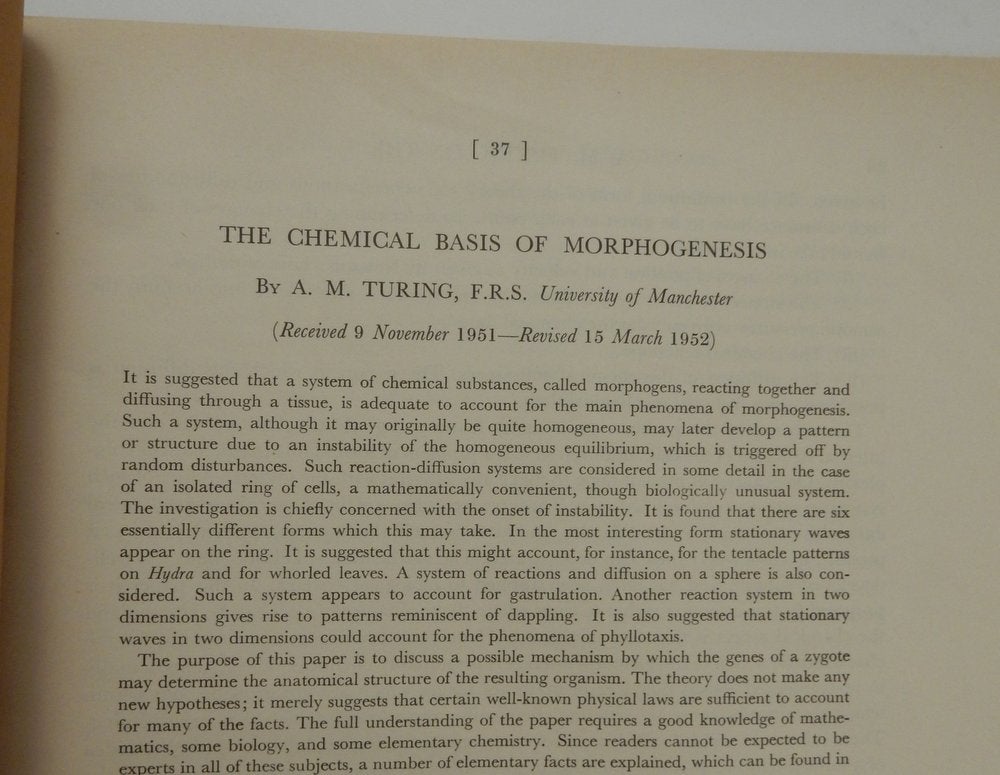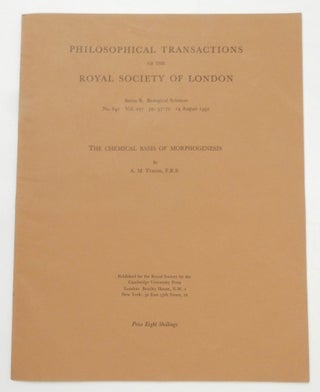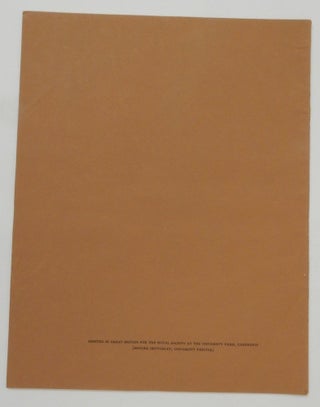The Chemical Basis of Morphogenesis
London and New York: Published for the Royal Society by the Cambridge University Press 1954. First Edition. 37-72 pages. 9 1/4 x 11 3/4 inches. Original printed light brown wrappers. Priced lower portion of front wrapper at eight shillings. Paper and spine paper and lettering intact, but this copy has creasing throughout, especially a soft crease to the upper right corner and smaller creasing to the spine panel edges. Very Good. Wraps. [27238]
The Chemical Basis of Morphogenesis has been called “hugely influential” in developmental biology and was used by Turing as a pioneering application in the emerging field of Artificial Life, where computers are often used to simulate living and life-like systems. "In this paper, Turing proposed that biological pattern formation arises in response to a chemical pre-pattern...Applications of Turing's work to developmental biology are too numerous to list but include limb development, pigmentation patterning, hair and feather germ formation, tooth morphogenesis, phyllotaxis, hydra patterning and regeneration. Moreover, ideas of self-organization now abound in biology, chemistry, and ecology...his paper has significantly advanced the field and the paper is being cited almost everyday." (Cooper)
“In his final years Turing worked on … Artificial Life (A-Life). The central aim of A-Life is a theoretical understanding of naturally-occurring biological life – in particular… its ability to self-organize (i.e. to develop form and structure spontaneously)... Turing was the first to use computer simulation to investigate a theory of 'morphogenesis'...he began this investigation as soon as the first Ferranti Mark I [computer] to be produced was installed at Manchester University...In June 1954, in the midst of this groundbreaking work, Turing died.” (Copeland)
A long-term scholarly project delving into the archival records of the Royal Society has uncovered some relevant information related to offprints (or “author separates”): “The change in 1934 was that authors were to be ‘supplied with the usual edition copies’, i.e. from the main print run, rather than printing extra copies.” Further, “by 1934, it made little sense to describe the author’s copies as if they were something different from the main print run: all the copies of Transactions papers were in some sense ‘separate copies’”
In other words, there is no way to distinguish between a regular publication copy and an offprint or author separate. They are the same physical objects from the same print run. Also, each articles by this time was published separately, not in gathered periodic publications. In this time period the print run was on the order of 800 copies.
Priced copies (as offered here) allowed the printer to sell additional copies to the public. But print runs were traditionally very small: “in 1883, Trübner [ then the printer ] returned ‘a large quantity of unsold stock of separate papers from Phil Trans’ and reported that he now believed ‘that not more than ten copies, instead of twenty-five’, of each article, would be sufficient to meet public demand.”
We submit that without new archival evidence concerning Philosophical Transactions of the Royal Society during this period, priced copies must be in an absolute sense much rarer than the regular, un-priced copies. These were not “commercial offprints” in the same way that some 20th century DNA and Einstein offprints were : produced to meet large demand for reprint requests from the public.
This work is surprisingly uncommon in the marketplace given Turing's stature and commands strong prices because of it's importance.
References: Cooper and van Leeuwen, Alan Turing his work and impact, p684-5. Copeland and others, Alan Turing's Electronic Brain, pp 136-7.
ITEM SOLD




